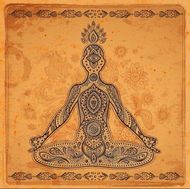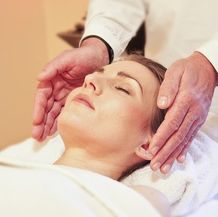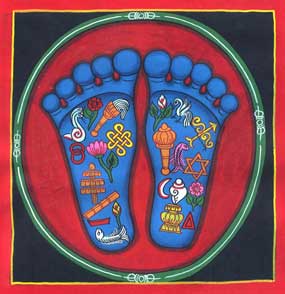|
I finally had the opportunity to take an online Zoom class with Bonnie Bainbridge Cohen, who is a pioneer in Body Mind Centering, a mindful philosophy of movement that is not Yoga and yet IS Yoga to its core. Less a type of exercise and more a means of cultivating awareness of the body through movement, Bonnie weaves together such topics and shifting away from biomechanical reductionism (concentric vs eccentric or flexion vs extension etc) towards moving from a "different place" (expansion vs contraction, responses vs answers to questions).
She spoke of "cellular consciousness", of using movement and awareness to awaken our cells to themselves. Each individual cell has certain functions that every other cell has, and yet may be differentiated between groups of cells performing certain actions while others are dedicated to other actions, such as digestive cells breaking down ingested nutrients while other cells differentiate between the nutrients, recombine them into what is needed, and then sending those nutrients where they need to go. Any part of this system can break down, and when one organization of cells is not working coherently it affects how other organizations of cells work. Think of our bodies not as one physical organism but a collection of them, our cells are collections of atoms and those atoms are collections of protons, electrons, and neutrons. Each one of us as individuals are then organized into collections of family units, communities of family units, and so on until we realize that collectively, nations are collections which form the larger ecosystem of the Earth, the solar system is a collection of planets, and so on as this universe is a collection of galaxies. We all notice when we don't feel well that often we have digestive disturbances; we get constipated or have diarrhea or have issues digesting certain foods. We may notice when one member of our family isn't feeling "right" and they act differently than they used too. We feel unsafe when some members of our community act in ways that are not beneficial to the community, when "rogue" nations take actions that make the world less safe. We as individuals can't always "fix" things to our own liking but we as individuals CAN work on how we react to things we can't change and take action on those things we CAN change. Perhaps we make a vow (vrata in Sanskrit) to be kind to strangers (hold the door for the person behind us), pick up the trash without being asked, ask someone who looks like they are having difficulty what can we do to help. These may seem like such simple inconsequential things but to the "other" they may help them to do the same for someone else. Not everyone is able or inclined to take big actions in a public arena but others do feel called to publicly demonstrate for the things they believe should happen. Perhaps one day we won't need to resist policies that systemically oppress others because we will recognize and remain conscious of how the harmonious relationships we cultivate with each other is a reflection of the harmonious relationships we are nurturing within our own bodies.
1 Comment
Spring is a time of renewal, when the chill of winter yields to warmth and the slumbering beings begin to stir. We feel the urge to emerge, spend time in sunlight with the sprouting greenery, and perhaps even desire more freshness in our food choices. Unfortunately, many of us find ourselves under Shelter in Place orders due to the novel Coronavirus, which forces us to remain sequestered against our instincts. But, as compassionate people, we know that in order to keep the vulnerable safer, we need to stay inside more than we wish. Let’s learn some powerful Yoga practices we can do inside our homes to help us face the stresses of remaining inwardly focused while preparing to return to the outside world. Your diet at this time should favor more seasonal cooked greens as you transition from heavier winter foods to lighter spring summer foods. Since these are stressful times adding a high anti-oxidant Ayurvedic jam called chyavanprash can help support your immune system in a tasty way without having to take a boatload of pills or capsules. Just take a teaspoon of the jam with your morning meal or even as a dessert! When you click through to the full article you will be on a local Ayurvedic company's website where you can learn more about it.
If you are interested in purchasing PIOR Living Chyawanprash, please use my affiliate link: https://piorliving.com/?ref=83 . You can also use my discount code of sandranicht for 25% off. Purchasing this way helps keep me fed and housed during these challenging times (and helps me buy my own jar of chyavanprash!). Well, I can't do yoga either if the definition is what might be seen on Instagram - young bendy women or super strong athletic men doing "impossible" feats of physical prowess that test the limits of strength and flexibility. Such things may only be possible for those who begin at a very young age, have the "right" genetics and the discipline to practice intensively over a long period of time.
But if we redefine what yoga is, away from a purely physical expression of youthful exuberance and towards a more intuitive and interoceptive expression of what an older time worn body needs, we can take exercises and movement sequences from any "tradition" - add breath awareness, link breath to movement and body positioning - and from this place make everyday activities into "yoga": a union of body, breath, awareness, and intention that can lead us towards healing. the Gentle Somatic Movement class I am currently teaching is a way to learn how to link awareness of your breath with awareness of how your body moves; the gradual addition of simple to more complex movements and patterns while imagining that the breath is the mover and not the muscles helps all of us practice moving in a more efficient manner. That stiffness we may feel when we first get up in the morning, especially if we are dealing with injuries, recovering from illnesses that restricted our movements, or the arthritis many of us associate with advancing age causes us to work too hard. How long have we been resisting our own efforts, can we learn how to get out of our own way? While gentle movement is great for recovery as well as stress management, we also need to keep our muscles strong, our joints stable, and our entire body supple. Learning to apply the principles of linking breath to movement while reducing excessive effort is continued in more vigorous formats: weight bearing activities are introduced, your sense of balance might be challenged but still we want to cultivate a sense of ease in our movements, find ways to get from Point A to Point B and beyond with less effort so we can do more and not feel overtired once we get there. This new moderate class may include a few more familiar echoes of the traditional asanas commonly used in westernized yoga classes. Both class formats introduce concepts, movements, and sequences with guidance and cuing but allow and encourage exploration and a sense of play - letting go of the rigidity of the more usual led class format we can develop a sense of self empowerment, a direct experience of our inner wisdom which the conscious mind obscures when it wanders. Your body has a voice that tells you when to "back off" or stop and observe if we can soften our ears to hear it... Be sure to fill out the survey on the hOMe page about the proposed new moderate class at Revolve! As this stressful year comes to a close you may wish to find the time to nurture and nourish your body, mind and soul. Learning to move gently and with less effort, relishing the support of bolsters and blankets while lying down, and being guided in the powerful meditation practice of Yoga Nidra, listening to and feeling the vibrations of Tibetan Singing Bowls is one beautiful way of helping your body recover from the rush of the holidays while settling the mind and calming the emotions.
This one-of-a-kind experience will be held at Keep It Simple Yoga on East Drive in Arbutus MD and will be facilitated by Sandra Nicht, who has been teaching and practicing for three decades. Sign up on the studio website,: https://www.simpleyoga.net/events Be sure to note the other workshops as you scroll for ours! And remember that Sandra teaches a yoga class there on Thursdays at 6 pm, currently an all levels slow flow but will be a somatic/gentle/restorative flow beginning next year (great for beginners as well as for experienced yogis!). We look forward to making your New Year a happy one! On the one hand, yoga for women need not be too different from yoga for anyone else - we all need to build muscular strength and endurance, many of us can use better joint range of motion as well as lung capacity, and we DEFINITELY all need to learn how to manage stress better.
On the other hand, yoga for women should be designed to help women cultivate the RIGHT kind of energy without depleting energy stores overall. Too many women strive for super strength or Cirque du Soleil flexibility without taking into consideration whether those things are truly needed for a better life. My class at the Lynne Brick's Women's Fitness Club in Owings Mills is designed to help those brand new to yoga practice learn how to manage their energy (and those with experience can also learn how to safely "power up" without overdoing). It IS possible to cultivate energy so you have more at the end of class than you did at the beginning! If you would like to try a class contact the club at (410) 363-4600. UPDATE: unfortunately this club is now closed. Please come to my Restorative Yoga class at the Padonia Brick Bodies club on Sundays 3 - 4:15 pm! It's never a good time to get a cold but there seems to be special kind of cold that shows up in spring. Emerging pollen combined with the heavier fare consumed in winter months can cause the energies that create mucus and phlegm to accumulate, aggravate, and then spill out our nasal passages. Sneezing, wheezing, coughing, and body aches make for a miserable one or two weeks. There may be no avoiding the occasional respiratory virus but there are ways to minimize the misery:
1. Use a neti pot! A neti pot is a little Aladdin's Lamp looking thing that helps you pass warm saline through one nostril to rinse the snot out the other (and then you repeat through the other nostril to complete the process). When very congested, use several times per day until the congestion is gone. You will be amazed at how well you can breathe and if you line your nostrils afterwards with a little oil or ghee you prevent your nasal lining from becoming dry and cracked which could allow other pathogens in! 2. Avoid dairy. Commercial dairy is very hard to digest because of the harmful ways industrial cows are treated (kept in confinement, separated from their calves, fed bovine growth hormone to force them to give more milk than they naturally would). And if you fell for the low fat scam, you have even MORE difficulty digesting this horrible product! If you have access to a certified raw milk farmer you will not experience this effect so much - indeed, you can make medicine out of whole raw milk by adding 1 tsp of turmeric powder to 1 cup raw milk and bringing to a boil (unless you prefer to maintain the enzymes that help you digest the milk). The fat in the whole milk help make the turmeric more bioavailable, makes it taste creamy, and slows the digestion of the milk sugars. Milk is anti inflammatory (when from a healthy source) and the turmeric also is anti inflammatory; the combination can be very rejuvenating to a tired body so at a very early stage perhaps this gives you the energy to fight and vanquish the germs. But if you are very congested you may wish to give up dairy at least for a while and make instead a tea of lemon, ginger, a pinch of mineral salt in hot water, and a little honey to taste. You can also try boiling 1 tsp each of tulsi, licorice, and turmeric powder in 4 cups hot water (with lid on) for 20 minutes and drink this 3x/day for 3 days if you are coughing from the post nasal drip that often accompanies colds. 3. Favor hot soups and stews over cold salads and sandwiches, warm cooked cereals with cinnamon instead of dry sugary stuff with cold industrial milk, hot herbal teas instead of cold sodas and smoothies. Cold things will increase the cold in your body, the hot and warm foods will help keep the mucus moving out. Remember to eat only when truly hungry so you can fully digest your food. 4. Rest! Go to bed early if you can so you can get up 8 hours later (more if necessary). Rest allows your body to concentrate on fighting the cold; pushing yourself only prolongs your agony or makes things worse.  Yoga Nidra means “yogic sleep” in the Sanskrit language, the original language of yoga. This isn’t the same thing as “shavasana”, the resting pose done at the end of most yoga classes but Yoga Nidra is often practiced in that pose. Yoga Nidra is a guided meditation practice often attributed to the Tantric tradition in India (Tantra being a philosophical tradition that emerged from the older Samkhya system that counts Ayurveda and Yoga as branches) and developed in modern times by the Bihar School of Yoga in India and refined and secularized by Richard Miller, PhD as the iRest (Integrative Restoration) method that has been scientifically studied for its effects on the recovering military population at Walter Reed Army Medical Hospital in Bethesda MD. Participants may practice lying down (with props for comfort if necessary and available) or sitting and are given time to settle into position and steady the breath before being directed to focus the mind on various things such as a specific part of the body (left big toe, right thumb, etc) or on principles of opposites (happiness, sadness; hot, cold). Some methods ask that focus be switched rapidly from one thing to the next, others allow for time to notice sensations as they arise while directly the observer to remain the observer and avoid attaching the mind to the sensations. The iRest method in particular delineates ten stages of practice from setting an intention to creating an inner resource or safe space within to draw on when or if difficulty arises with a particular direction, all the way to learning how to see and accept life as it is without judgement, a very powerful tool for reducing the effects of stressful situations. You are not supposed to fall asleep during Yoga Nidra but sometimes it happens due to excessive fatigue; not to worry, though the conscious mind may clock out for a time the subconscious mind still receives the vibrations of the directions spoken and the body still gains the benefits! This make it a wonderful addition to any exercise program; rest days are needed to recover from work or intense exercise routines and adding a directed healing meditation to a rest day supercharges the body’s ability to recover and rejuvenate itself. Even if you feel no bodily fatigue or stress Yoga Nidra is beneficial for sharpening the mind’s ability to focus and concentrate. There are no complicated skills to master, no strength or flexibility required to participate, ANYONE in ANY CONDITION fit or frail can benefit from Yoga Nidra! To sign up for the Yoga Nidra Reiki workshop with me and Phila Hoopes on Saturday May 5 from 4 - 6 pm (save by signing up ahead of time!) please visit https://www.eventbee.com/v/relaxrenewreplenishyoganidra-reiki#/tickets  By Phila Hoopes The word Reiki combines two Japanese words - Rei, meaning "God's Wisdom or the Higher Power" and Ki, meaning "life force energy". So you can define Reiki as "spiritually guided life force energy." Reiki is a Japanese healing technique by which this energy is transmitted through the laying on of hands to support relaxation and relief from stress, pain, and illness in the mind, body or spirit, and promote healing. So, you may say, we’re looking at some serious “woo” here, right? Actually – while practitioners may take a wide range of approaches, some more “woo-woo” than others, traditional Usui Reiki is gaining genuine recognition in the world of conventional medicine. While mainstream science hasn’t yet identified how it works, the National Center for Complementary & Alternative Medicine (NCCAM) of the National Institutes of Health (NIH) classifies Reiki as a form of biofield therapy. Researcher Pamela Miles teaches that Reiki affects the vibrational body, gently supporting its natural self-healing mechanisms by fostering balance.* In the 95 years since Mikao Usui established the practice of Reiki, practitioners have found that it may be used effectively for anyone, human or nonhuman, in person or remotely. It supports all other medical or alternative approaches to relieve symptoms and side effects and promote recovery. Because it involves no physical manipulation, nor the ingestion or application of any drugs, creams, or oils, it has no known contraindications. It’s impossible to be allergic to Reiki! For all of these reasons, Reiki is used as a supplement to conventional and integrative care in 76 hospitals in the U.S. and abroad, treating a wide range of conditions including:
So, you may ask – what does Reiki feel like? Well, you remain clothed, and you may be sitting or lying down. The practitioner may gently place hands on your body – or may hold hands a few inches above your body – in a series of locations roughly corresponding to the chakras. You may feel warmth, heat, or tingling in those areas, and most people report feeling a sense of relaxation that deepens as the session progresses. A session may be as short as 15 minutes or as long as 90. Afterward, you may feel sleepy – or energized! It’s common to experience shifts, whether physical, psychological or emotional: if you have been blocked in some way (whether it’s, say, constipation, a charley-horse, or blocked emotions), you may experience a release. To integrate your Reiki experience and energy release, be gentle to yourself! Drink plenty of water, get plenty of sleep (and pay attention to your dreams!). Observe your experience with love and acceptance, remembering that this is energy moving. If you experience a major psychological or emotional release, stay in contact with your therapist to process the thoughts and feelings. And if you have any questions, please contact me at phila@allrelationsreiki.com. I look forward to seeing you! _____________________________________________ * Pamela Miles, Reiki: A Comprehensive Guide (New York: Penguin, 2008), 8  There seems to be a lot of controversy about NFL players "taking a knee" during the playing of the National Anthem. As an act of peaceful protest against the unequal treatment of black men (who are shot, injured, arrested, incarcerated) in disproportionately large numbers to the white population, kneeling instead of standing is a powerful visual meant to be disruptive but ultimately meant to cause some soul searching in the audience. But kneeling has also been used as an act of bowing to authority, of showing contrition, of demonstrating a prayerful attitude, and as part of a marriage proposal. Kneeling was never considered an act of disrespect until now. There is a powerful pull for individuals to conform to actions performed in a group; standing to recite a loyalty oath with hand over heart, as in the Pledge of Allegiance, allows individuals to blend in, to demonstrate that they are part of the group. When one person declines to remain part of the group they are often ostracized, as Colin Kaepernick has been. If others in the group join the one person and their numbers grow, those who sympathize with the original protest but who were previously afraid to fully express themselves can feel more courageous in their new group. This can result in dramatic positive change, as when Dr. Martin Luther King Jr. inspired massive peaceful protests against segregation (and violent backlashes by authorities), or in equally dramatic displays of assumed racial supremacy as with the recent marches by neo Nazis and white supremacists (which usually resulted in violent clashes with anti fascists). As practitioners of yoga we are part of a group striving to create peace and balance within ourselves, hoping that this will spread to the larger community. Some work very hard to project "love and light" at all times while denying the shadow within themselves (unless you are a saint and have no shadows). Others work very hard to deny the light and embrace the shadows of race hatred, extreme nationalism and xenophobia. Most are somewhere in between, trying to make the world a better place but still on occasion lapsing into reflexive expressions of patriotism, or concerns about violence in "those neighborhoods". It has been said that when we are truly peaceful within our own hearts that expressions of violence will cease. We can strive all we want to practice the Yamas and Niyamas of Patanjali but perfect Ahimsa (non violence, the first Yama) is impossible. We must kill to nourish ourselves (plants are sentient beings too), we commit violence in some form (mild or otherwise) every day in speech, thought, and sometimes in deed. The deeper work lies in cultivating equanimity as in the Bhagavad Gita - gaining the strength to do the things we must do while remaining unattached to the results. This should not result in doing nothing in the face of injustice; even small gestures can begin the transformation in someone else. As we are seeing in the #TakeTheKnee movement. Can you feel if you tend to put more of your weight onto one foot or to one side of the foot? Can you feel the effects of your habitual standing posture on your back? Do you know how to adjust your foot positioning while walking or running, can you feel the effects of that positioning on your knees? Have you ever worked out your feet the way you work out your arms, chest, shoulders, back, abs or legs?
The next time you are outdoors in a natural (and safe) setting, take off your shoes and allow your feet to luxuriate in the feel of the grass. Wiggle your toes, walk slowly across the ground while paying attention to how you can roll from heel to toe in slow motion; feel for all the bumps and irregularities in your path. Can you also notice how this slow mindful walking meditation feels in your legs, torso, and mind? It's okay if you don't notice anything, keep practicing anyway and see if anything shifts in your awareness. Contrast how you feel when walking outdoors with how you feel barefoot in your home, the difference between carpet, rug, wood floor, stone. Now see if you can coordinate your breathing with each step; choose a rhythm you can maintain and make your inhale and exhale relatively even in length (or make the exhale a little longer) and as smooth as possible (try not to suck the air in quickly or forcefully push the air out). For example, if you choose to try a 4 second inhale and 4 second exhale, take the entire 4 seconds to breathe in, and the entire 4 seconds to breathe out (and remember you can breathe out for longer). Once you have your breath rhythm it's time to try your mindful walking with the breath. Can you take the entire 4 seconds it takes to breathe in to take one step? Can you do the same with your exhale? Can you sustain this practice for 5 minutes, 10 minutes, or longer? Or do you have the time to forget about time and just practice until it feels like the right time to end it? When finished, sit quietly for a few minutes and notice the effects whatever they might be. Smile to yourself, fold your hands in prayer and bow your head, or find another formal way of ending your practice if you wish. See if you can maintain the feeling of the practice while moving on the next part of your day. Repeat! |
Proudly powered by Weebly



 RSS Feed
RSS Feed